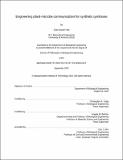Engineering plant-microbe communication for synthetic symbioses
Author(s)
Toth, Tyler Daniel
DownloadThesis PDF (3.051Mb)
Advisor
Voigt, Christopher A.
Belcher, Angela M.
Terms of use
Metadata
Show full item recordAbstract
Current agricultural practices will not be able to keep pace with a growing population in a changing climate. A better understanding and increased reliance on the symbiotic relationships between plants and their resident microbiome will be crucial in addressing this challenge. In addition, these microbes provide a promising location for genetic engineering efforts and should be viewed as an integral part of an engineerable agricultural system. This holistic view means that desired functions can be performed in the host most suitable for the task, reducing toxicity due to resource limitations, and potentially easing regulatory concerns. Attaining this view, however, requires synthetic forms of communication between plants and microbes that are orthogonal to native signaling pathways, able to diffuse through the complex soil environment, readily produced from common cellular precursors, and easily sensed at low concentrations.
In this thesis, I review the genetic parts and regulators available for use in plants and the types of natural and engineerable plant-microbe communication. I then highlight the potential use of plant-to-microbe communication to control gene expression in engineered soil bacteria – specifically to ensure that the energy-intensive expression of nitrogenase only occurs when microbes are near a plant. Finally, I share the creation of an engineered form of microbe-to-plant communication. We engineered plants with the ability to sense and respond to bacterial quorum signals separate from native responses. In addition, we show that the p-coumarate homoserine lactone (pC-HSL) sensors can respond to pC-HSL biosynthesized by Pseudomonas putida grown in proximity to the plants. To the best of our knowledge, this is the first demonstration of engineered microbe-to-plant communication using a small molecule. We were also able to place the biosynthesis of pC-HSL under the control of various sensors and use an engineered consortium to perform logical operations on multiple environmental inputs. This engineered form of synthetic symbiosis lays the foundation for using microbe-to-plant communication to perform tasks such as monitoring soil nutrients, sensing pathogens, or detecting environmental contaminants.
Date issued
2022-09Department
Massachusetts Institute of Technology. Department of Biological EngineeringPublisher
Massachusetts Institute of Technology